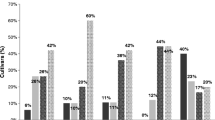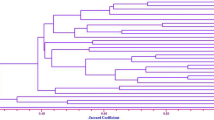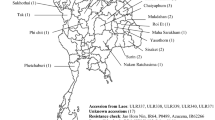Abstract
Rice blast (Magnaporthe oryzae) is the most destructive and epidemic disease of rice. Use of host resistance is the best alternative for disease management. The leaf and neck blast resistance of 182 rice breeding lines were assessed for leaf and neck blast and classified relative to a susceptible check-Masuli and resistant check-Laxmi, from greenhouse experiment in 2005 and 2006. The test plants were inoculated with 105 conidial suspension/ml of M. oryzae at 21 days old seedlings for the leaf blast, and at neck base for the neck blast. Among them, for leaf blast, 77 rice lines were resistant, 43 were moderately resistant, 39 were moderately susceptible and 23 were susceptible. While among the selected 31 rice lines evaluated for neck blast, 4 lines were resistant, 4 were moderately resistant, 16 were moderately susceptible and 7 were susceptible. Leaf and neck infection was significant and positively correlated (r = 0.30, P = 0.05). The rice lines, Barkhe 1032, Barkhe 1034, Barkhe 1035, Barkhe 1036, Barkhe 2014, Barkhe 2024, Barkhe 3019, Super 3004 were resistant to leaf blast and Barkhe 1006, Barkhe 1032, Barkhe 1035, Barkhe 3004 were resistant to neck blast. The rice lines with identification # 11, 69, 137, 168, 182 from Masuli × MT4 parentage, and Barkhe 3017 were susceptible to both leaf and neck blast. Progenies of Irradiated Pusa Basmati (IPB), Kalinga III/IR64 (KIII/IR64), and Masuli/IR64 were resistant to both leaf and neck blast. However, most progenies from Masuli/MT4 showed susceptible reaction to both leaf and neck blast. Thus, rice lines form the IPB, KIII/IR64 and Masuli/IR64 will be promising resistant sources for rice blast in breeding programme.







Similar content being viewed by others
References
Adhikari TB, Shrestha SM (1986) Blast (Bl) epidemic in Chitwan valley, Nepal. Int Rice Res Newsl 11:22
Anderson AL, Henry BW, Tullis EC (1947) Factors affecting infectivity, spread, and persistence of Piricularia oryzae Cav. Phytopathology 37:94–110
Asaga K, Yoshimure S (1970) Field resistance of sister line cross to leaf and panicle blast. (Abstr.). Proc Kanto-Tosan Plant Prot Soc 17:7
Balal MS, Selim AK, Hassanian SH, Maximoss MA (1977) Inheritance of resistance to leaf and neck blast to rice. Egypt J Genet Cytol 6:332–341
Bhardwaj CL, Singh BM (1983) Evaluation of blast resistant rice varieties in Himalchal Pradesh. Indian Phytopathol 36:453–456
Bonman JM (1992) Durable resistance to rice blast- environmental influences. Euphytica 63:115–123. doi:10.1007/BF00023917
Bonman JM, Mackill DJ (1988) Durable resistance to rice blast disease. Oryza 25:103–110
Bonman JM, Vergel de Dios TI, Khin MM (1986) Physiologic specialization of Pyricularia oryzae in the Philippines. Plant Dis 70:767–769. doi:10.1094/PD-70-767
Bonman JM, Estrada BA, Bandong JM (1989) Leaf and neck blast resistance in tropical lowland rice cultivars. Plant Dis 73:388–390. doi:10.1094/PD-73-0388
Bonman JM, Estrada BA, Kim CK, Ra DS, Lee EJ (1991) Assessment of blast disease and yield loss in susceptible and partially resistant rice cultivars in two irrigated low land environments. Plant Dis 75:462–466
Bonman JM, Khush GS, Nelson RJ (1992) Breeding rice for resistance to pests. Annu Rev Phytopathol 30:507–528. doi:10.1146/annurev.py.30.090192.002451
Candole BL, Siebenmorgen TJ, Lee FN, Cartwright RD (1999) The effect of panicle blast on the physical properties and milling quality of rice cultivar ‘M202’. Res Ser-Arkansas Agric Exp Stn 468:142–147
Chaudhary B (2001) Rice blast: pathogenic variability and host resistance. Thesis, MSc, Tribhuvan Universiy, IAAS, Rampur, Chitwan, Nepal
Chaudhary RN (1996) Techniques for screening rice genotypes for resistance to the blast fungus and its crude extract toxin. Thesis, M.Sc, Kasetsart University, Bangkok, Thailand, p 97
Chaudhary B, Karki BP, Lal KK (1994) Neck blast resistant lines of Radha-17 isolated. Int Rice Res Notes 19:11
Chin KM (1975) Fungicidal control of the rice blast disease. Malays Agric J 50:221–228
Correa-Victoria FJ, Zeigler RS (1993) Pathogenic variability in Pyricularia grisea at a rice blast ‘hot spot’ breeding site in Eastern Colombia. Plant Dis 77:1029–1035
Couch BC, Kohn LM (2002) A multilocus gene genealogy concordant with host preference indicates segregation of a new species, Magnaporthe oryzae, from M. grisea. Mycologia 94:683–693. doi:10.2307/3761719
Das MK, Rajaram S, Mundt CC, Kronstad WE (1992) Inheritance of slow rusting resistance to leaf rust in wheat. Crop Sci 32:1452–1456
Disthaporn S (1994) Current rice blast epidemics and their management in Thailand. In: Zeigler RS et al (eds) Rice blast disease. CAB International, Wallingford, in association with IRRI, Manila, pp 333–342
Filippi MC, Prabhu AS (2001) Phenotypic virulence analysis of Pyricularia grisea isolates from Brazilian upland rice cultivars. Pesqui Agropecu Bras 36:27–35. doi:10.1590/S0100-204X2001000100004
Hossain M, Khalequzzaman KM, Mollah MRA, Hussain MA, Rahim MA (2004) Reaction of breeding lines/cultivars of rice against brown spot and blast under field condition. Asian J Plant Sci 3:614–617
Hwang BK, Koh YJ, Chung HS (1987) Effects of adult-plant resistance on blast severity and yield of rice. Plant Dis 71:1035–1038. doi:10.1094/PD-71-1035
IRRI (International Rice Research Institute) (1989) IRRI towards 2000 and beyond. International Rice Research Institute, Manila, p 66
IRRI (International Rice Research Institute) (2002) Standard evaluation system for rice. IRRI, Manila
Johnson R (1981) Durable resistance: definition of, genetic control, and attainment in plant breeding. Phytopathology 71:567
Kahn RP, Libby JL (1958) The effect of environmental factors and plant age on the infection of rice by the blast fungus, Pyricularia oryzae. Phytopathology 48:25–30
Kim CH, Rush MC, MacKenzie DR (1986) Flood-mediated resistance to the rice blast disease. In: Juo ASR, Lowe JA (eds) The wetlands and rice in Subsaharan Africa. International Institute of Tropical Agriculture, Ibadan, pp 151–160
Koh YJ, Hwang BK, Chung HS (1987) Adult plant resistant to rice blast. Phytopathology 77:232–236. doi:10.1094/Phyto-77-232
Luo Y, Tebeest DO, Teng PS, Fabellar NG (1995) Simulation studies on risk analysis of rice leaf blast epidemics associated with global climate-change in several Asian countries. J Biogeogr 22:673–678. doi:10.2307/2845969
Manandhar HK, Shrestha K, Amatya P (1992) Seed-borne diseases. In: Mathur SB et al (eds) Plant diseases, seed production and seed health testing in Nepal. Danish Government, Institute of Seed Pathology for Develo** Countries, Copenhagen, pp 59–74
McCouch S, Nelson R, Tohme J, Zeigler R (1994) Map** blast resistance genes in Rice. In: Zeigler RS et al (eds) Rice blast disease. CAB International, Wallingford, in association with IRRI, Manila, pp 167–186
Miah SA, Shahjahan AKM, Hossain MA, Sharma NR (1985) A survey of rice diseases in Bangladesh. Trop Pest Manage 31:208–213
Notteghem JL, Silue D (1992) Distribution of mating type alleles in Magnaporthe grisea population pathogenic on rice. Phytopathology 82:421–434. doi:10.1094/Phyto-82-421
Ono K, Suzuki H (1960) Studies on mechanism of infection and ecology of blast and stem rot of rice plants (in Japanese, English summary); Spec. Rept. Forecast Disease Insect Pests, p 156
Ou SH (1985) Rice diseases, 2nd edn. Commonwealth Mycological Institute, Kew, p 380
Ou SH, Nuque FL (1963) The relation between leaf and neck blast resistant to the rice blast disease. Int Rice Commonw Newsl 12:30–34
Padmanabhan SY (1965) Recent advances in the study of blast diseases of rice. Madras Agric J (Golden Jubilee Number):546–583
Pinnschmidt HO, Teng PS, Yong L (1994) Methodology for quantifying rice yield effects of blast. In: Zeigler RS et al (eds) Rice blast disease. CAB International, Wallingford, in association with IRRI, Manila, pp 381–408
Prabhu AS, Faria JC, Zimmermann FJP (1989) Comparative yield loss estimates due to blast in upland rice cultivars. Fitopatol Bras 14:227–232
Prabhu AS, Filippi MC, Araújo LG, Faria JC (2002) Genetic and phenotypic characterization of isolates of Pyricularia grisea from the rice cultivars Epagri 108 and 109. Fitopatol Bras 27:566–573
Roumen EC (1992) Effect of leaf age on partial resistance in rice to leaf blast. Euphytica 63:271–279
Shi D, Tao RX, Sun SY (1995) Cluster analysis on the blast resistance of some japonica varieties. Acta Agric Zhejiangensis 7:486–488
Teng PS (1994) The epidemiological basis for blast management. In: Zeigler RS et al (eds) Rice blast disease. CAB International, Wallingford
Thruston HD (1998) Tropical plant diseases, 2nd edn. APS press, American Phytopathological Society, St. paul, pp 31–40
Tuite J (1969) Plant pathological methods, fungi and bacteria. Burgess Publishing, Minneapolis, pp 239
Vingnanakulasingam V (1991) Inoculation techniques and assessments of residual resistance to neck blast in near isogenic lines of rice. Thesis M.Sc, Faculty of the Graduate School, University of the Philippines at Los Banos
**a JQ, Correll JC, Lee FN, Ross WJ, Rhoads DD (2000) Regional population diversity of Pyricularia grisea in Arkansas and the influence of host selection. Plant Dis 84:877–884. doi:10.1094/PDIS.2000.84.8.877
Yeh WH, Bonman JM (1986) Assessment of partial resistance to Pyricularia oryzae in six rice cultivars. Plant Pathol 35:319–323. doi:10.1111/j.1365-3059.1986.tb02021.x
Zeigler RS, Tohme J, Nelson RJ, Levy M, Correa-Victoria FJ (1994) Lineage exclusion: a proposal for linking blast population analysis to resistance breeding. In: Zeigler RS et al (eds) Rice blast disease. CAB International, Wallingford, in association with IRRI, Manila, pp 267–292
Acknowledgements
The authors are thankful to Department for International Developments (DFID), Plant Science Research Programme (PSRP), UK, LI-BIRD, and to the Directorate of Research, IAAS Rampur, Nepal for the financial support to this study. We are grateful to S. Gyawali for reviewing the manuscript.
Author information
Authors and Affiliations
Corresponding author
Rights and permissions
About this article
Cite this article
Puri, K.D., Shrestha, S.M., Khhatri Chhetri, G.B. et al. Leaf and neck blast resistance reaction in tropical rice lines under green house condition. Euphytica 165, 523–532 (2009). https://doi.org/10.1007/s10681-008-9771-9
Received:
Accepted:
Published:
Issue Date:
DOI: https://doi.org/10.1007/s10681-008-9771-9




